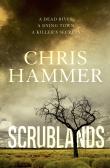 8315570537457945024.jpg
8315570537457945024.jpg
 8315570537457945024.jpg
8315570537457945024.jpg
'Set in a fictional Riverina town at the height of a devastating drought, Scrublands is one of the most powerful, compelling and original crime novels to be written in Australia
'In an isolated country town brought to its knees by endless drought, a charismatic and dedicated young priest calmly opens fire on his congregation, killing five parishioners before being shot dead himself.
'A year later, troubled journalist Martin Scarsden arrives in Riversend to write a feature on the anniversary of the tragedy. But the stories he hears from the locals about the priest and incidents leading up to the shooting don't fit with the accepted version of events his own newspaper reported in an award-winning investigation. Martin can't ignore his doubts, nor the urgings of some locals to unearth the real reason behind the priest's deadly rampage.
'Just as Martin believes he is making headway, a shocking new development rocks the town, which becomes the biggest story in Australia. The media descends on Riversend and Martin is now the one in the spotlight. His reasons for investigating the shooting have suddenly become very personal.
'Wrestling with his own demons, Martin finds himself risking everything to discover a truth that becomes darker and more complex with every twist. But there are powerful forces determined to stop him, and he has no idea how far they will go to make sure the town's secrets stay buried.' (Source: Publisher's blurb)
 Scrublands
2023
Australia
:
Easy Tiger Productions
Nine Network
Stan
,
2023
27155089
2023
series - publisher
film/TV
thriller
Scrublands
2023
Australia
:
Easy Tiger Productions
Nine Network
Stan
,
2023
27155089
2023
series - publisher
film/TV
thriller
Investigative journalist Martin Scarsden works to uncover the truth of the case of killing of five parishioners by a charismatic and dedicated young priest.
In September 2018, it was announced that the book had been optioned for television: no further details available. (See https://www.smh.com.au/entertainment/books/the-new-thirst-for-australian-crime-reads-20180821-p4zyt0.html).
Dedication: For Tomoko
A brief review of this work appeared in The New York Times 20 January 2019
'In 1997, Stephen Knight described Australian crime fiction as a genre that is ‘thriving but unnoticed’ (Continent of Mystery 1). While in recent years Australian crime fiction has gained more attention amongst both academics and reviewers, it is still missing from an area of study in which I believe it demands more notice—that is, ecocritical discussions of Australian fiction. In this paper, I investigate the idea of Australian crime fiction as a largely underexplored representation of the modern environmental crisis, discussing how modern Australian crime fiction often portrays the troubling relationship between human violence and the settler-colonial decimation of Australia’s natural environments and nonhuman animals. Such a relationship indirectly alludes to the impact of a changing climate on Australian communities and ecosystems and suggests that popular genre fiction can contribute in profound ways to broader environmental considerations. With this ecocritical framework in mind, this paper analyses the representation of drought, bushfire and the nonhuman in Jane Harper’s The Dry (2016) and Chris Hammer’s Scrublands (2018), and what such texts reveal to readers about the criminal nature of anthropogenic climate change and the settler-colonial destruction of Australian habitats.' (Publication abstract)
'Why has Australian ‘rural noir’ become so popular? Crime novelist Garry Disher investigates'
'Crime writer Chris Hammer knows plot matters but he thinks people are even more important, as he tells Stephen Romei'
'Why has Australian ‘rural noir’ become so popular? Crime novelist Garry Disher investigates'
'In 1997, Stephen Knight described Australian crime fiction as a genre that is ‘thriving but unnoticed’ (Continent of Mystery 1). While in recent years Australian crime fiction has gained more attention amongst both academics and reviewers, it is still missing from an area of study in which I believe it demands more notice—that is, ecocritical discussions of Australian fiction. In this paper, I investigate the idea of Australian crime fiction as a largely underexplored representation of the modern environmental crisis, discussing how modern Australian crime fiction often portrays the troubling relationship between human violence and the settler-colonial decimation of Australia’s natural environments and nonhuman animals. Such a relationship indirectly alludes to the impact of a changing climate on Australian communities and ecosystems and suggests that popular genre fiction can contribute in profound ways to broader environmental considerations. With this ecocritical framework in mind, this paper analyses the representation of drought, bushfire and the nonhuman in Jane Harper’s The Dry (2016) and Chris Hammer’s Scrublands (2018), and what such texts reveal to readers about the criminal nature of anthropogenic climate change and the settler-colonial destruction of Australian habitats.' (Publication abstract)